Simulation Analysis of High Radiant Heat Plant Cooling and Endothermic Screen Waste Heat Recovery Performance Based on FLUENT
Abstract
:1. Introduction
2. Numerical Experiment
2.1. Physical Model
2.2. Principle of Waste Heat Recovery Device
2.3. Endothermic Screen Arrangement
2.4. Simulation Model
2.5. Mesh Division
2.6. Simulation Setup
- (1)
- Ignore the viscous dissipation in the energy equation;
- (2)
- The surface emissivity and absorption rate of each material do not change with temperature;
- (3)
- The physical parameters of the endothermic screen do not change with temperature;
- (4)
- The physical parameters of air and water only change with density with temperature, and other parameters are considered unchanged.
2.7. Analysis of Heat Dissipation
3. Results and Discussion
3.1. Stability Analysis of Heat Source
3.2. Analysis of Indoor Monitoring Point
3.3. Analysis of Average Indoor Temperature
3.4. Analysis of Endothermic Screen Outlet Water Temperature
3.5. Waste Heat Recovery Efficiency
4. Conclusions
- (1)
- In this paper, it is derived that radiant heat transfer dominates the heat dissipation of a high radiant heat source, and the convective heat transfer with air is negligible.
- (2)
- The endothermic screen can significantly reduce the indoor temperature when working, and the cooling range is 7.67 K, which has a cooling effect.
- (3)
- The waste heat recovery efficiency of the endothermic screen is about 56%, which can absorb most of the high radiant heat emitted by the heat source. The high-temperature environment in the plant is optimized. The endothermic screen can be used in high radiant heat plants such as metallurgical and thermal power plants.
Author Contributions
Funding
Data Availability Statement
Conflicts of Interest
Nomenclature
| Symbol Description | |
| heat dissipation of High radiant heat source, W | |
| high radiant heat source and indoor air radiation heat transfer, W | |
| convective heat transfer between the surface of a high radiant heat source and indoor air, W | |
| high radiant heat source surface area, m2 | |
| high radiant heat source surface emissivity, dimensionless | |
| Stephen–Boltzmann constant, σ = 5.67 × 10−8 W/(m2·K4) | |
| high radiant heat source surface temperature, T | |
| ambient air temperature, T | |
| high convective heat transfer coefficient between radiant heat source and surrounding air, W/(m2·K) | |
| constant, dimensionless | |
| constant, dimensionless | |
| thermal conductivity of the air in the plant, W/(m·K) | |
| high-radiation heat source characteristic length, m | |
| Gr | Grashof number, dimensionless |
| Pr | Prandtl number, dimensionless |
| g | acceleration of gravity, g = 9.8 m/s2 |
| volume expansion coefficient of air in the plant, 1/K | |
| kinematic viscosity coefficient of air in the plant, m2/s | |
| aerodynamic viscosity coefficient in the plate, N/(m2/s) | |
| air constant pressure specific heat capacity of the plant, J/(kg·K) | |
| I | ratio of radiative heat dissipation to convective heat exchange for high radiant heat sources, dimensionless |
| heat recovery efficiency, dimensionless | |
| absorption of heat from cooling water in the endothermic screen tube | |
| Lower Corner | |
| rad | radiation heat |
| con | convection heat |
| a | air |
| p | plant |
| w | water |
References
- Johnson, I.; Choate, W.T.; Davidson, A. Waste Heat Recovery. Technology and Opportunities in U.S. Industry; BCS Inc.: Washington, DC, USA, 2008. [Google Scholar]
- Royo, P.; Acevedo, L.; Arnal, Á.J.; Diaz-Ramírez, M.; García-Armingol, T.; Ferreira, V.J.; Ferreira, G.; López-Sabirón, A.M. Decision support system of innovative high-temperature latent heat storage for waste heat recovery in the energy-intensive industry. Energies 2021, 14, 365. [Google Scholar] [CrossRef]
- Chen, W.H.; Chiou, Y.-B.; Chein, R.Y.; Uan, J.Y.; Wang, X.D. Power generation of thermoelectric generator with plate fins for recovering low-temperature waste heat. Appl. Energy 2022, 306, 118012. [Google Scholar] [CrossRef]
- Sidik, N.A.C.; Kean, T.H.; Chow, H.K.; Rajaandra, A.; Rahman, S.; Kaur, J. Performance enhancement of cold thermal energy storage system using nanofluid phase change materials: A review. Int. Commun. Heat Mass. Transf. 2018, 94, 85–95. [Google Scholar] [CrossRef]
- Meng, X.; Wang, Y.; Lv, Y.; Yang, H. Characteristics analysis of convection and radiatation in industrial plants with high temperature heat source. Heat. Vent. Air Cond. 2016, 46, 36–39. [Google Scholar]
- Hendricks, T.; Choate, W.T. Engineering Scoping Study of Thermoelectric Generator Systems for Industrial Waste Heat Recovery; US Department of Energy: Washington, DC, USA, 2006. [Google Scholar]
- Ammar, Y.; Joyce, S.; Norman, R.; Wang, Y.; Roskilly, A.P. Low grade thermal energy sources and uses from the process industry in the UK. Appl. Energy 2012, 89, 3–20. [Google Scholar] [CrossRef]
- Zhang, S.; Zhu, N.; Lu, S. Responses of human perception and skin temperature to directed thermal radiation in hot environments. Build. Environ. 2021, 197, 107857. [Google Scholar] [CrossRef]
- Li, X.; Chow, K.H.; Zhu, Y.; Lin, Y. Evaluating the impacts of high-temperature outdoor working environments on construction labor productivity in China: A case study of rebar workers. Build. Environ. 2016, 11, 42–52. [Google Scholar] [CrossRef]
- Piver, W.T.; Ando, M.; Ye, F.; Portier, C.J. Temperature and air pollution as risk factors for heat stroke in Tokyo, July and August 1980–1995, Environment. Health Perspect. 1999, 107, 911–916. [Google Scholar] [CrossRef] [PubMed]
- Arifwidodo, S.D.; Chandrasiri, O. Urban heat stress and human health in Bangkok, Thailand. Environ. Res. 2020, 185, 109398. [Google Scholar] [CrossRef]
- Jing, Z.; Zhu, N.; Lu, S. Productivity model in hot and humid environment based on heat tolerance time analysis. Build Environ. 2009, 44, 2202–2207. [Google Scholar]
- Gay, L.; Gracia, R.; Mongruel, S.; Wizenne, E. Effects of cable fire smoke on electronic boards. Fire Saf. Sci. 2014, 11, 1035–1048. [Google Scholar] [CrossRef]
- Zhu, C.; Deng, X.; Zhang, R.; Lu, J.; Meng, Q.; Li, S.; Jiang, H. Numerical Analysis of Spray Cooling on the Roof Surface of Industrial Factory—Based on the Humidity and Temperature Environment. Ind. Technol. Innov. 2018, 5, 83–88. [Google Scholar]
- Nayak, A.K.; Hagishima, A.; Tanimoto, J. A simplified numerical model for evaporative cooling by water spray over roof surfaces. Appl. Therm. Eng. 2020, 165, 114514. [Google Scholar] [CrossRef]
- Yang, Y.; Cai, Y.; Huang, Y.; Liu, Z.; Xu, F. Fuzzy Optimization Research on Thermal Comfort of Atrium Space in Ofice Buildings under the Natural Ventilation Environment. J. Hum. Settl. West China 2022, 37, 119–125. [Google Scholar]
- Zhao, Y.; Shi, F.; Jiang, D. Numerical simulation and analysis of air conditioning cooling effect at working face. China Coal 2011, 37, 108–111. [Google Scholar]
- Wang, X.; Zhang, H.; Yang, H.L.; Chen, H.K.; Hu, Z.J. High Temperature Resistant Heat Insulating Material Simulation and Experimental Verification. Aerosp. Mater. Technol. 2014, 44, 92–96. [Google Scholar]
- She, X.; Cong, L.; Nie, B.; Leng, G.; Peng, H.; Chen, Y.; Zhang, X.; Wen, T.; Yang, H.; Luo, Y. Energy-efficient and -economic technologies for air conditioning with vapor compression refrigeration: A comprehensive review. Appl. Energy 2018, 232, 157–186. [Google Scholar] [CrossRef]
- Walker, R.; Pavía, S. Thermal performance of a selection of insulation materials suitable for historic buildings. Build. Environ. 2015, 94, 155–165. [Google Scholar] [CrossRef]
- Zhao, Z.; Luo, L.; Qiu, D.; Wang, Z.; Sundén, B. On the solar air heater thermal enhancement and flow topology using differently shaped ribs combined with delta-winglet vortex generators. Energy 2021, 224, 119944. [Google Scholar] [CrossRef]
- Zäll, E.; Nordenström, A.; Järn, M.; Mossegård, J.; Wågberg, T. Environmentally sustainable electroplating of selective cobalt-chromium coating on stainless steel for efficient solar collectors. Sol. Energy Mater. Sol. Cells 2022, 245, 111821. [Google Scholar] [CrossRef]
- Kim, J.; Lee, J.-H.; Song, T.-H. Vacuum insulation properties of phenolic foam. Int. J. Heat Mass Transf. 2012, 55, 5343–5349. [Google Scholar] [CrossRef]
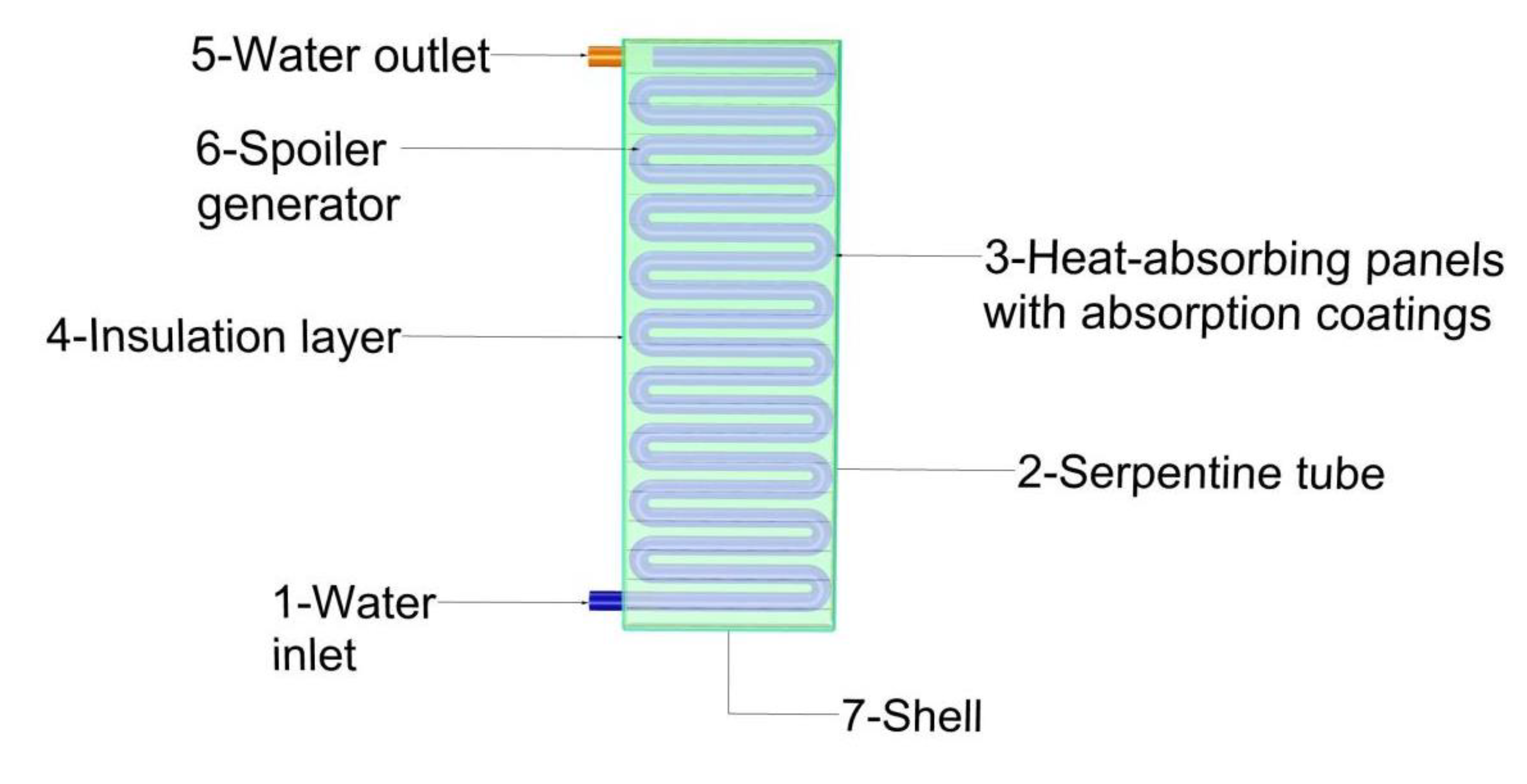

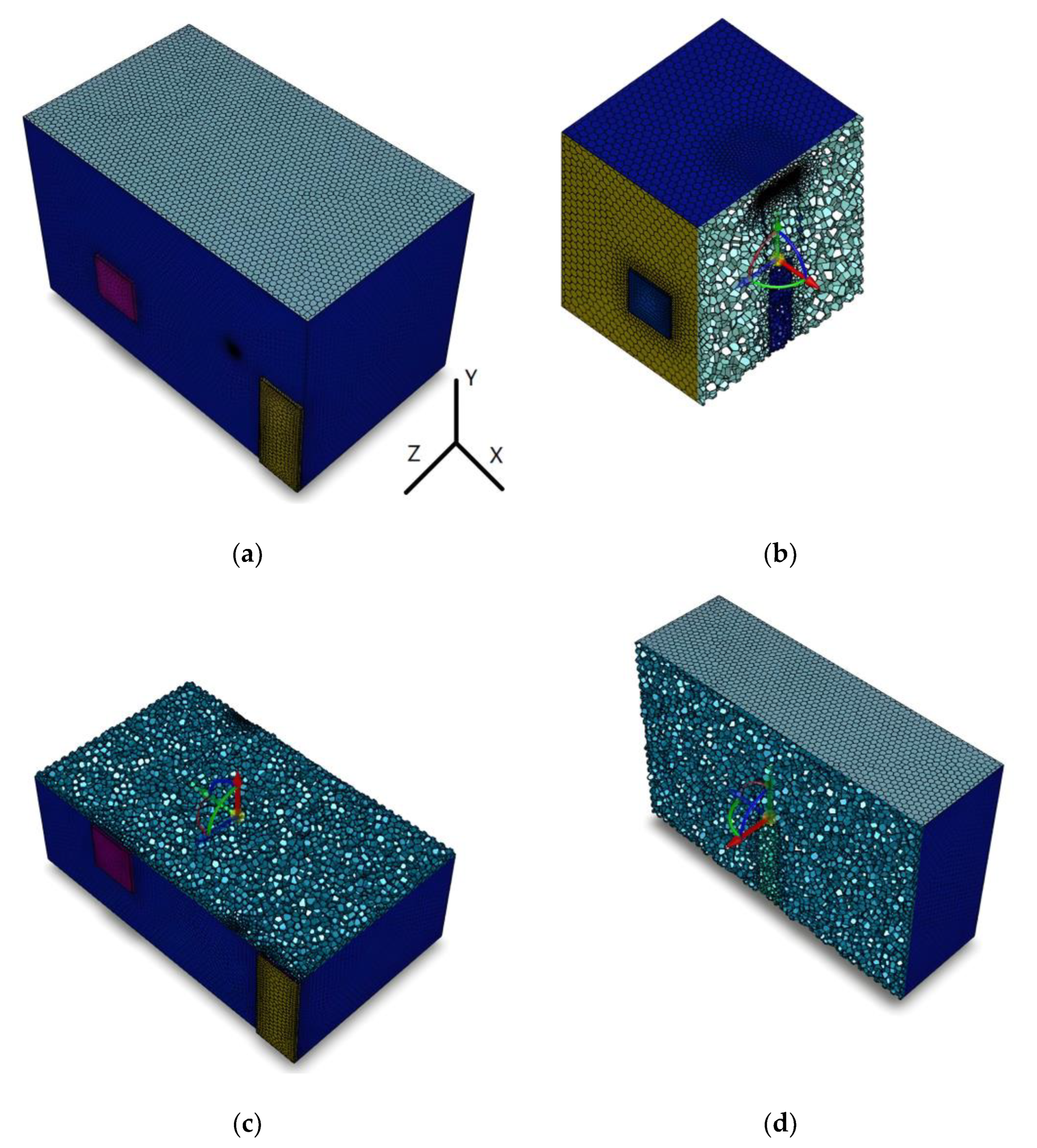

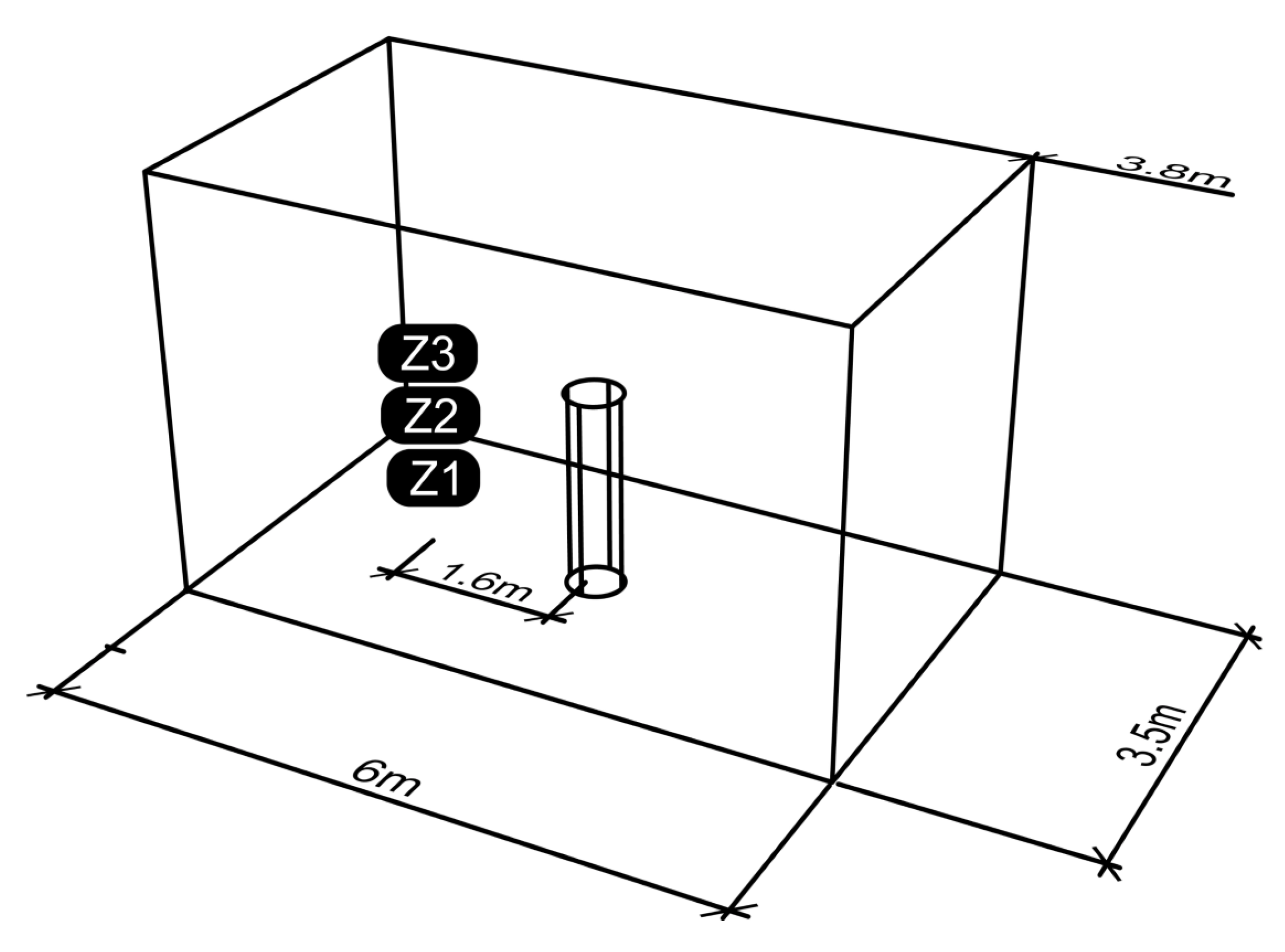

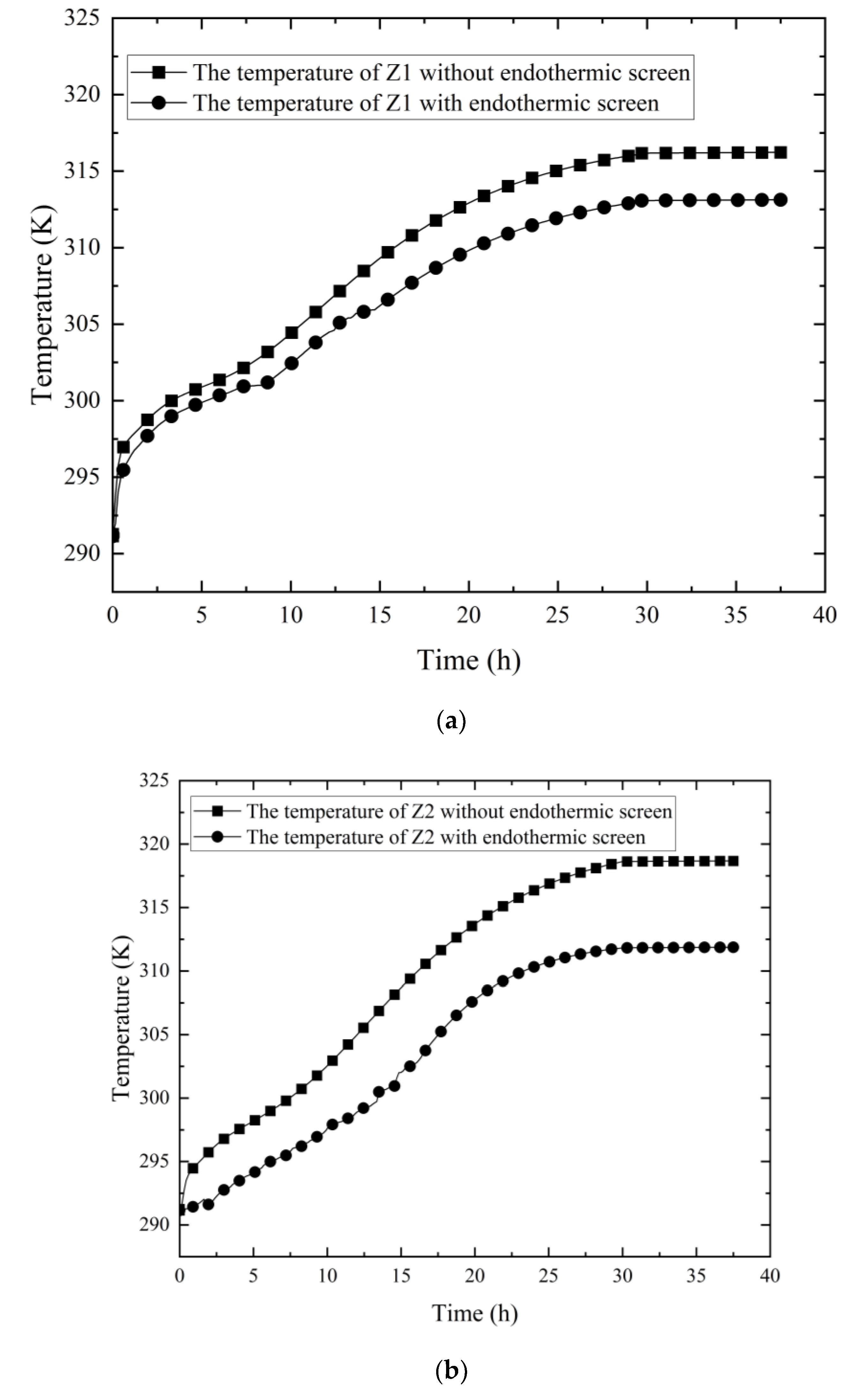
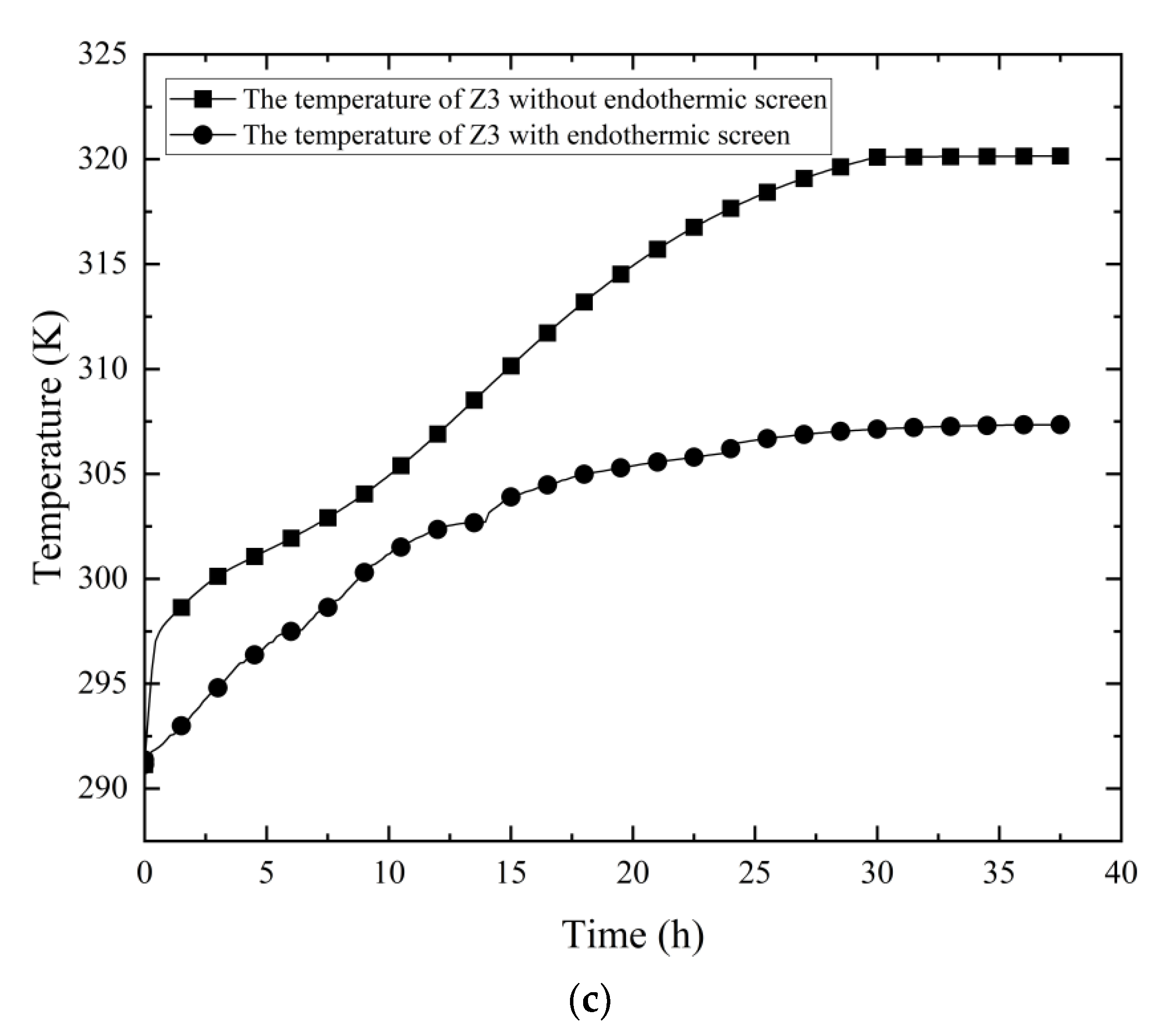

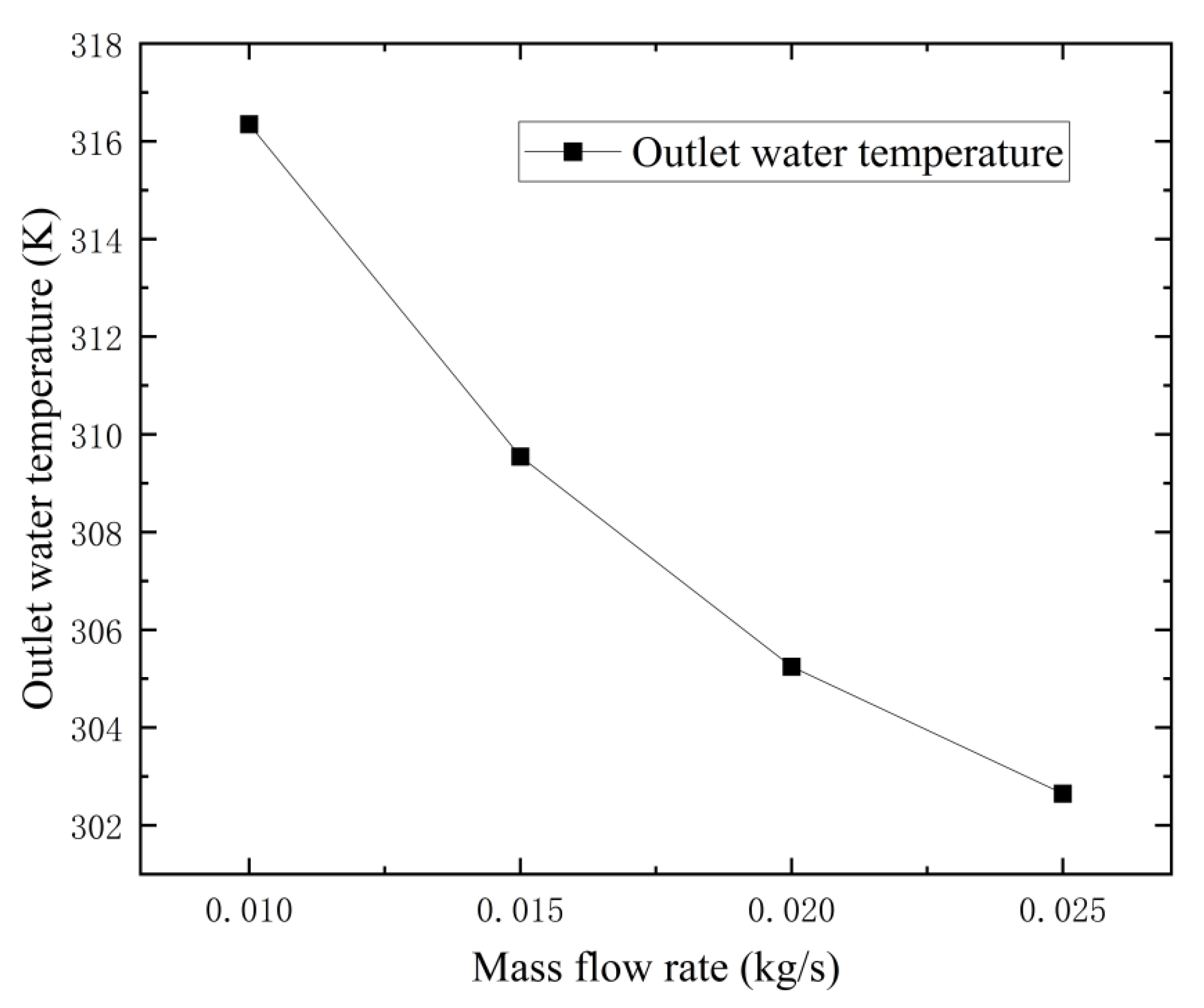


| Title | Parameters | Title | Parameters |
|---|---|---|---|
| length, width and height of the room (mm) | 6000, 3500, 3800 | Thickness of shell, endothermic board and insulation layer (mm) | 1.5, 1, 40 |
| length, width and thickness of the door (mm) | 2000, 800, 50 | diameter of Serpentine tube (mm) | 25 |
| length, width and thickness of the window (mm) | 900, 900, 5 | distance of Serpentine tube (mm) | 20 |
| length, width and thickness of the endothermic screens (mm) | 1600, 700, 92.5 |
| Name of Material | Density Ρ (kg/m3) | Specific Heat Capacity cp (J/kg·K) | Thermal Conductivity Λ (W/m·K) | Viscosity μ (kg/m·s) |
|---|---|---|---|---|
| water | 998.62 | 4200 | 0.599 | 1.81 × 10−5 |
| air | 1.205 | 1004 | 0.0267 | 0.001003 |
| wood | 710 | 1720 | 0.15 | / |
| glass | 2500 | 837 | 1.09 | / |
| stainless steel | 502.48 | 7920 | 16.27 | / |
| copper | 8960 | 390 | 387 | / |
| aluminum alloy | 2700 | 880 | 155 | / |
| phenolic foam | 50 | 2730 | 0.023 | / |
| brick wall | 1850 | 1000 | 0.4 | / |
| Boundary Name | Parameter Settings |
|---|---|
| Wall | hybrid boundaries, surface emissivity: 0.9, convective heat transfer coefficient: 8 W/(m2 K) |
| Window | hybrid boundaries, surface emissivity: 0.93, convective heat transfer coefficient: 4 W/(m2 K) |
| Door | hybrid boundaries, surface emissivity: 0.85, convective heat transfer coefficient: 1.75 W/(m2·K) |
| Endothermic plate | fluid–structure interaction boundary, opaque media, absorptivity: 0.96 |
| Serpentine tube | fluid–structure interaction boundary, opaque media |
| Shell | hybrid boundaries, surface emissivity: 0.55, convective heat transfer coefficient: 0.45 W/(m2·K) |
| Endothermic screen fluid inlet | speed inlet, inlet temperature: 18 °C; mass flow: 0.01 kg/s, 0.015 kg/s, 0.02 kg/s, 0.025 kg/s |
| Endothermic screen fluid outlet | pressure outlet |
| Type | Options | Parameters |
|---|---|---|
| Discrete items | Discrete Ordinates | First Order Upwind |
| Energy | First Order Upwind | |
| Momentum | Second Order Upwind | |
| Press | Body Force Weighted | |
| Gradient | Least Squares Cell Based | |
| Relaxation factors | Press | 0.3 |
| Density | 1 | |
| Body Forces | 1 | |
| Momentum | 0.7 | |
| Turbulent Kinetic Energy | 0.8 | |
| Discrete | 1 | |
| Residuals | Continuity | 0.001 |
| X Velocity | 0.001 | |
| Y Velocity | 0.001 | |
| Z Velocity | 0.001 | |
| Energy | 1 × 10−6 | |
| Initialization | K | 0.001 |
| Epsilon | 0.001 | |
| Initialization Methods | Standard Initialization | |
| Temperature© | 18 |
Disclaimer/Publisher’s Note: The statements, opinions and data contained in all publications are solely those of the individual author(s) and contributor(s) and not of MDPI and/or the editor(s). MDPI and/or the editor(s) disclaim responsibility for any injury to people or property resulting from any ideas, methods, instructions or products referred to in the content. |
© 2023 by the authors. Licensee MDPI, Basel, Switzerland. This article is an open access article distributed under the terms and conditions of the Creative Commons Attribution (CC BY) license (https://creativecommons.org/licenses/by/4.0/).
Share and Cite
Wang, H.; Zhai, J. Simulation Analysis of High Radiant Heat Plant Cooling and Endothermic Screen Waste Heat Recovery Performance Based on FLUENT. Energies 2023, 16, 4196. https://doi.org/10.3390/en16104196
Wang H, Zhai J. Simulation Analysis of High Radiant Heat Plant Cooling and Endothermic Screen Waste Heat Recovery Performance Based on FLUENT. Energies. 2023; 16(10):4196. https://doi.org/10.3390/en16104196
Chicago/Turabian StyleWang, Haitao, and Jianfeng Zhai. 2023. "Simulation Analysis of High Radiant Heat Plant Cooling and Endothermic Screen Waste Heat Recovery Performance Based on FLUENT" Energies 16, no. 10: 4196. https://doi.org/10.3390/en16104196





